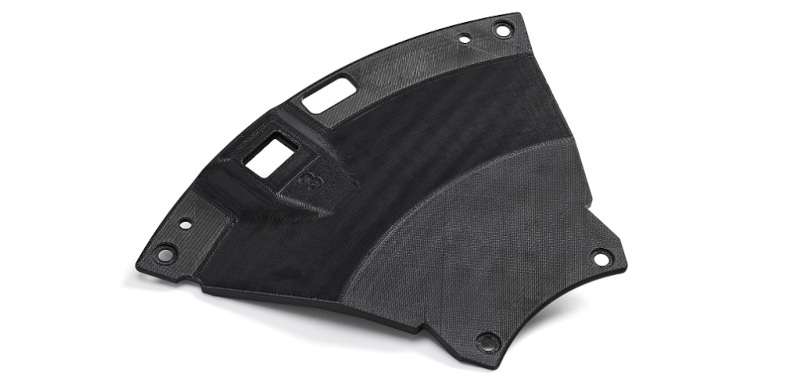
Hexagon, Stratasys partner to simplify use of PEKK 3D-print material for aerospace
By DE Staff
Additive Manufacturing AerospaceDigimat now includes simulation of Antero 840CN03 and 800NA to ease use of thermoplastics for lightweighting.

Lockheed-Martin’s docking hatch cover for NASA’s Orion spacecraft, 3D printed with Stratasys’ PEKK-based Antero thermoplastic.
(Photo credit: Stratasys Inc.)
Hexagon’s Manufacturing Intelligence division and Stratasys announced they have validated Stratasys’ Antero reinforced polyetherketoneketone (PEKK) materials and its additive manufacturing processes using Hexagon’s simulation technology.
According to the companies, 3D printed plastic parts offer significant lightweighting for aerospace, but the industry has been slow to use plastics and AM for structural components due to safety-critical nature and regulations.
To overcome these barriers, multi-scale models of these materials — Stratasys Antero 840CN03 and Antero 800NA – have been added to Hexagon’s Digimat materials exchange ecosystem, with associated print process parameters from Stratasys’ aerospace-ready 3D printers. Using these detailed proprietary models, engineers can create digital twins that accurately predict how parts printed with the chosen material and Stratasys printer will perform.
Hexagon’s Digimat software allows for the design of lighter parts that match metals in performance. According to Hexagon, companies that use Digimat in conjunction with Hexagon’s MSC Nastran and MSC Apex can accelerate the certification and documentation of their work.
The Antero 840CN03 is a PEKK-based thermoplastic for FDM that incorporates carbon nanotubes for consistent electrostatic dissipative (ESD) properties. Antero 800NA material is a PEKK-based FDM thermoplastic with mechanical properties that include high strength, high heat resistance, toughness, and wear-resistance. According to Stratasys, its Antero materials are being used in aerospace engineering, such as Lockheed Martin using Antero 840CN03 to create NASA’s Orion spacecraft docking hatch cover.
“As the aerospace industry continues to push for more sustainable designs, unlocking the lightweighting potential of thermoplastics and 3D printing will be key,” said Aziz Tahiri, VP of global aerospace and defence for Hexagon’s Manufacturing Intelligence division. “By leveraging the power of our simulation technology, manufacturers gain access to proprietary information so their engineers can ‘work the problem’ with reliable information. We’re excited to see how this next chapter with Stratasys will help the industry create lighter, stronger designs in any design engineering tool with more confidence and less cost and help bring next-gen aircraft to market faster.”
https://hexagon.com
www.stratasys.com
